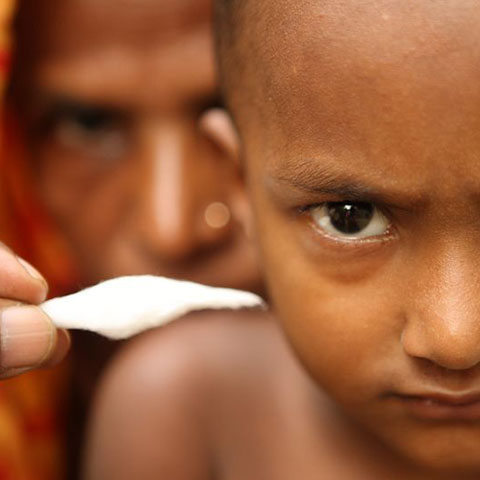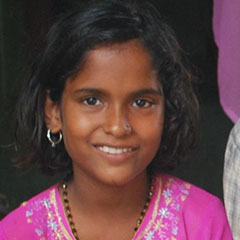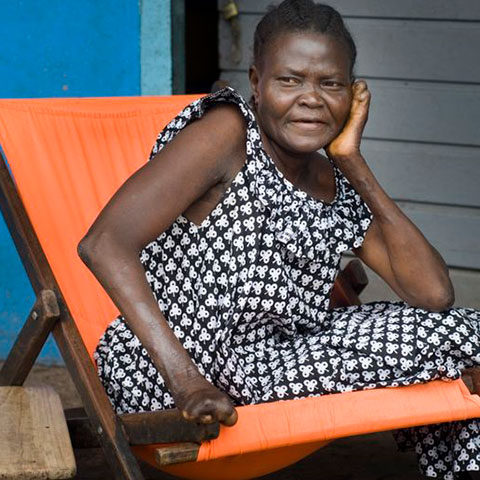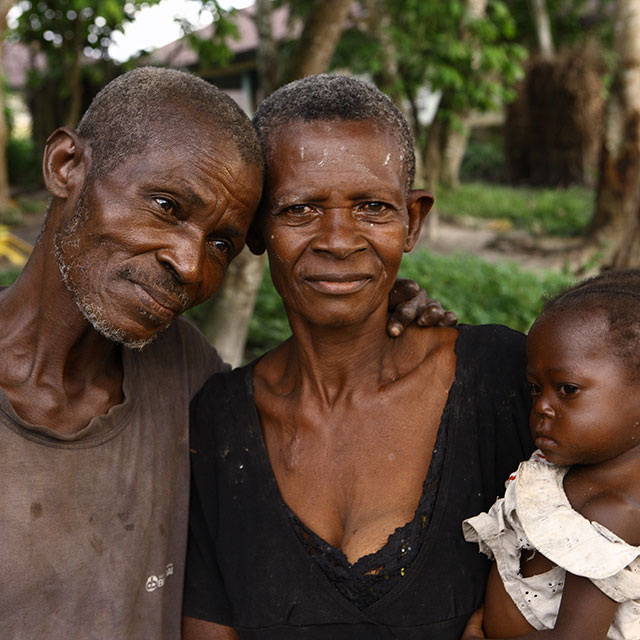About Leprosy
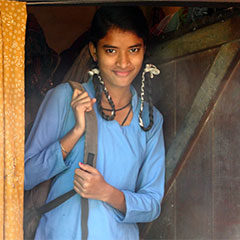
The basics
What causes leprosy?
Leprosy is a disease caused by a bacillus, Mycobacterium leprae. It multiplies very slowly and the incubation period can be a number of years (on average about 5 years).
What are the symptoms?
For many people the first signs of leprosy are pale patches of skin or numbness in the fingers or toes. This is because the disease mainly affects the nerves and skin. If left untreated, it can lead to nerve damage, loss of feeling (sensation) and paralysis of muscles in the hands, feet and face.
Can it be cured?
The good news is that most of these consequences can be avoided. Since 1981 leprosy has been treated effectively with multi drug therapy (MDT), a combination of three antibiotic drugs: dapsone, rifampicin and clofazimine. A six to twelve month course of treatment kills the bacteria and cures the person. If treated in the early stages of disease, MDT can usually prevent the onset of impairments and disabilities.
How can it cause disabilities?
The bacteria attack nerve endings and destroy the body’s ability to feel pain and injury. Other nerves controlling muscles can also be damaged, leading to weakness and paralysis, especially of hands and feet. Although the bacteria can damage the nerves directly, the body’s immune response can also cause similar damage through a mechanism we call a leprosy reaction. Without feeling pain, people don’t realise when they injure themselves and their injuries can become infected. Changes to the skin also leave the person susceptible to ulcers, which if left untreated, can cause further damage, wounds and visible disfigurements to the face and limbs. If the facial nerve is affected, this can interfere with a person’s ability to blink, which can eventually cause blindness.
How is it spread? Is it contagious?
Leprosy is most likely transmitted by air through droplets from the nose and mouth, during close and frequent contacts with people who have not yet been treated. While it is spread in a similar way to the common cold, it is much less infectious. It multiplies slowly and the vast majority of people have adequate natural immunity, so don’t contract the disease if exposed. Even when diagnosed, many cases are not considered infectious, and once treatment begins, those infectious cases become non-infectious within the first week of treatment.
But I thought it was eliminated?
The World Health Organization declared leprosy ‘eliminated’ as a public health problem at a global level in 2000. This was based on a definition of less than one case per 10,000 people across a larger population. This did not mean total eradication of the disease: there were still many cases in pockets all over the world, and around 200,000 new cases are reported globally each year. Regrettably, once WHO announced ‘elimination’, resources were often focused on other diseases and efforts to find and treat new cases diminished
How many people are affected today?
Beyond the 200,000 new cases that are reported annually, there are likely to be many more living with undiagnosed leprosy. Further, there are an estimated 3-4 million people who have been cured of the disease, but experience residual effects of disability, and perhaps as many again who, even without visible impairments, are experiencing the stigma and discrimination that so often accompany the label ‘leprosy’.
Where is it found?
Leprosy is reported in 107 countries (2021 data), with 80% of all new cases occurring in India, Brazil and Indonesia.
How can it be ended once and for all?
It is unlikely that leprosy can be eradicated, as the bacillus also occurs in some animal species (notably the nine-banded armadillo). Among humans, the slow growth of the bacillus means that, even with the best of today’s tools, elimination of the disease is a long journey. ILEP is working in support of WHO’s target of a 70% reduction in new cases by 2030, using the best tools currently available. However, the stigma still associated with leprosy is a barrier to ending transmission, as people are often reluctant to get diagnosed or seek help. It can also have a devastating impact on people’s lives, long after they have been cured. For this reason, ILEP’s strategy is Triple-Zero: we work to stop the transmission of leprosy, prevent disabilities and promote social inclusion by ending stigma and discrimination.
Diagnosis & classification of leprosy
Leprosy is caused by the bacillus Mycobacterium leprae. It is a chronic and slow-developing disease whose manifestations can range from a single skin patch or a single thickened nerve through to more widespread effects on the skin and nerves. The slow progression of the disease is often punctuated by damaging episodes of leprosy reaction. The nerve involvement in leprosy can lead to deformities and physical impairments, which in turn may lead to the disabling consequences of stigmatisation and social exclusion. For these reasons, the early diagnosis and prompt treatment of leprosy are essential.
Diagnosis
Normally, the diagnosis of leprosy rests on finding any one of three cardinal signs:
- A definite loss of sensation in one or more pale (hypopigmented) or reddish skin patches;
- One or more thickened or enlarged peripheral nerves with a loss of sensation and/or weakness in the muscles supplied by the nerve; or
- The presence of acid-fast bacilli in a slit skin smear.
The diagnosis of leprosy is often complicated by the fact that the way it presents depends on the type and strength of the body’s immune response to M. leprae.
Immune response and classification
Most people have an effective immune response to leprosy which completely prevents the disease from developing. Others have a moderate response which allows the disease to appear but limits it to only a few skin patches. In these patients, the number of leprosy bacilli in the body is quite small (less than a million) and the disease is classified as paucibacillary or PB (meaning ‘few bacilli’). A very small minority of people have such a weak immune response to the leprosy bacillus that it can multiply almost without any check and spread to almost all parts of the skin and the peripheral nerves. In these patients the skin smear is positive and the disease is classified as multibacillary or MB (meaning ‘many bacilli’).
This straightforward classification system, in which all patients fall into one of the two categories PB and MB, is recommended by WHO for the purposes of simplicity. Patients with five patches or less are classified as PB. However, the disease in fact manifests in a more or less continuous spectrum from high to low immunity with a wide range of different presentations, so some clinicians use the older, but more detailed, Ridley/Jopling classification, which has five main groupings.
Treatment of leprosy
MDT treatment
As a bacterial infection, leprosy is treated with antibiotics. Multidrug therapy (MDT) was introduced by WHO in 1981 and consists of the three drugs rifampicin, clofazimine and dapsone. The WHO Leprosy Guidelines recommend two regimens: a six-month course of drugs for paucibacillary (PB) leprosy and a twelve-month or longer course for multibacillary (MB) leprosy. [See Diagnosis and classification of leprosy]. These treatments are highly effective and cure 98% of patients with leprosy infection. The relapse rate is very low and there are few reports of multi-drug resistance.
MDT is supplied free of charge by the pharmaceutical company Novartis through WHO. It is supplied in blister packs which contain a month’s medication. Since its introduction, more than 20 million patients have had their leprosy cured through MDT.
There are side effects to MDT. Around 1% of patients may experience dapsone hypersensitivity syndrome which has potentially severe consequences. Clofazamine causes skin discoloration which is problematic for patients at risk of stigmatisation because it signals that they are taking treatment for leprosy. There is also a risk of anaemia when taking MDT.
Reaction treatment
Leprosy reactions are the inflammation of skin patches, nerves or the eyes. They are the main cause of nerve damage and disability in leprosy, so recognition and prompt treatment of reactions is crucial. Around half of MB patients will develop leprosy reactions before, during or even after MDT treatment. They are due to changes in immunity: they do not mean that the MDT is not working. Leprosy reactions are often chronic, and when inflammation is associated with the nerves, nerve function impairment and/or pain will result. Treating reaction patients with steroids is often required for clinical improvement, and in some cases very prolonged treatment is necessary. Thalidomide, where available and used with effective systems for managing risks, is another highly effective drug in the management of some forms of leprosy reaction.
Neuropathic pain
Tingling or burning pains in treated skin lesions, or in hands and feet, can be a late and long-term complication of leprosy. Neuropathic pain can be severe and can worsen the feelings of depression that are often associated with leprosy diagnosis and treatment. Patients should be given appropriate pain treatments depending on the severity of the pain, and consideration needs to be given to anti-depression treatment or therapeutic counselling.
Self-care
If damage has already been caused to the nerves, MDT alone will not restore function and other forms of treatment and care are needed. Physiotherapy will assist patients to improve muscle function. A lifetime of attentiveness and self-care will be needed if patients are to prevent damage to hands and feet, and dressings and antibiotics are necessary if wounds occur.
Prevention of leprosy
The essential features of leprosy control are early detection, prompt treatment with multidrug therapy [see Treatment of Leprosy] and management of contacts (especially the household contacts of new cases). In recent years there has been progress in other aspects of leprosy prevention, including chemoprophylaxis and immunoprophylaxis.
Contact management
Leprosy control programmes consisting only of early detection and treatment with MDT have not interrupted the transmission of the disease. Contact management – long neglected in many countries due to lack of resources – is now considered an essential component of effective programmes.
Contact management starts with tracing the contacts of new leprosy patients. This consists of identifying the household members and close social contacts of a new patient – with the patient’s consent – and either visiting their homes or inviting them to a health centre, to be examined for symptoms of leprosy. Research studies in the 2000s showed that the likelihood of finding a household contact with previously undiagnosed leprosy was ten times greater than in the general population. Increasingly, contact management includes the provision of preventive interventions to these contacts.
Chemoprophylaxis
A number of research studies over the years have examined the preventive effects of different drugs or drug combinations. The most rigorous trial, in Bangladesh during the 2000s, gave a single dose of rifampicin – one of the three MDT drugs – to an average of 20 contacts per new patient and showed a 57% reduction in the incidence of leprosy over a two-year period. The WHO Guidelines for Leprosy, issued in 2018, recommend the routine use of single dose rifampicin as Post-Exposure Prophylaxis (PEP) to contacts, with potential mass application to larger groups at risk such as islands and other ‘hot spot’ areas. A large programme of pilot projects was launched in 2016 by the Novartis Foundation, in collaboration with several national leprosy programmes and ILEP Members, to demonstrate the feasibility, acceptability, cost-effectiveness, and real-world efficacy of contact tracing and PEP as a strategy for interrupting leprosy transmission. The experiences from these and other pilot projects have been incorporated into WHO technical guidance to support widespread implementation.
Immunoprophylaxis
The BCG vaccination against tuberculosis (TB) has been found to offer some protection against leprosy when given at a young age. Research trials where BCG is given at an older age, or as a revaccination, show inconsistent results. Ironically, BCG may be more effective in preventing leprosy than in preventing TB, and there is some concern about the negative effects for leprosy if its use in TB is phased out.
Research and early human trials are going on in the US, Brazil and India towards a more specific leprosy vaccine. It is considered likely that a successful vaccine would be targeted at specific risk groups such as ‘hot-spot‘ areas of high incidence, at household contacts rather than whole populations, and possibly also as a therapeutic vaccine alongside MDT.
Rehabilitation & prevention of disability
Physical impairments are a common result of the nerve damage caused by leprosy. Some people suffer damage to eyes, hands or feet before and during treatment, and continue to be at risk for their lifetime after the infection has been cured. For many people, the social and economic consequences of leprosy are even more damaging than the physical consequences.
The challenge in rehabilitation is to lessen or even reverse the bodily impairment, activity limitation and participation restriction that result from leprosy, so that the person can live as normal a life as possible. Rehabilitation focuses on the functioning of the individual rather than the disease, so leprosy rehabilitation programmes need to be multi-faceted. They may involve corrective surgery, physiotherapy and occupational therapy, and assistive devices. But they are also likely to involve aspects of individual empowerment – enabling people to manage self-care, develop new livelihoods, and other adaptations – and community education and advocacy that work towards enabling people to fully participate in society.
Physical rehabilitation
Physical rehabilitation seeks to help people affected by the muscle weakness or physical damage caused by leprosy, in the normal activities of daily life. Physiotherapy exercises are designed to strengthen muscles. Occupational therapy, including the use of assistive devices, is intended to compensate for physical impairments, improve functional skills and foster independence. Assistive devices, accompanied by special training, are also important to protect anaesthetic hands from further injury.
Surgery can correct some damaging consequences of leprosy including paralysis and clawing of hands, foot drop and lagophthalmos (paralysis preventing eyes from closing). Patients suffering from neuritis and foot ulcers benefit from splints and special footwear designed to assist in healing.
Self-care
Leprosy often causes the skin to become very dry as a result of damage to the nerves that control sweating. People with nerve damage therefore need to examine feet and hands daily, checking for cracks, wounds, callouses and swollen areas, and have a daily routine of soaking the feet, scraping off dry skin, and applying oil. If, despite best efforts, ulcers develop, then resting and protecting the wound are essential to avoid further damage. Because the discipline of daily self-care can be challenging for individuals, many patients find it helpful to join self-care groups.
The right footwear can greatly reduce the risk of foot damage. In the past, leprosy patients were often given specially made shoes, but as communities identified these shoes with leprosy, they became a source of stigma. People are increasingly encouraged to buy their own shoes but given advice to avoid making choices that would damage the feet. Some ILEP Members are experimenting with technologies such as 3D printing to make footwear that targets individual patients’ needs.
Socio-economic rehabilitation
In the past, rehabilitation was primarily about physical function and rehabilitation programmes were usually based in hospitals or similar institutions. However, many people affected by leprosy face the loss of their livelihoods as a result of prolonged hospitalisation or the loss of physical capacity or the ongoing risk of damage to hands and feet. Pushed to the margins of society, many find themselves living in slums where the infrastructures completely fail to support basic human needs such as housing, sanitation and education. Socio-economic rehabilitation seeks to help people affected by leprosy to rebuild their lives through, for example, vocational training, micro-finance and business creation schemes, provision or improvement of appropriate housing, and advocacy at various levels to ensure that persons affected by leprosy and their family members are fully included in society.
Community-based rehabilitation
In more recent years, community-based rehabilitation or CBR has been introduced as a strategy within community development for rehabilitation, equalisation of opportunities, poverty reduction, and social inclusion. The essence of CBR is the ‘twin-track’ approach: mainstreaming (including people with disabilities, including leprosy, in mainstream community development as much as possible) plus disability-specific services and care where they are needed. CBR therefore includes factors like gaining or regaining a livelihood and becoming fully included in the life of the community. For people affected by leprosy, the quest for dignity in the face of societal stigma has led to a focus on individual and group empowerment, and on challenging discriminatory attitudes in the community and state.
Stigma, discrimination & mental wellbeing
Leprosy can be a devastating diagnosis, especially for people living in some of the world’s poorest and most marginalised communities. Individuals affected by leprosy often experience rejection, shame and social exclusion, with consequences for mental health. Stigma, prejudice, and discrimination can also prevent people with the symptoms of leprosy from seeking and accessing medical help, which delays diagnosis and treatment. Ending the stigma and the laws and practices that discriminate against people affected by leprosy and their families is therefore essential to achieving zero leprosy.
Discriminatory laws and regulations
Laws and regulations that discriminate against people affected by leprosy still exist in many countries today. ILEP maintains the most up-to-date database of legal discrimination. As at early 2023 there were 130 laws in place that discriminate against people affected by leprosy in 23 countries. Many of these laws have their origins in 19th century policies of compulsory segregation of people affected by leprosy from their communities, for which there has never been a scientific basis. ILEP is active in lobbying for the repeal of all discriminatory laws and regulations.
Social discrimination
In communities, stigma can operate through the apparatus of the state and also through myths and traditions that, in some countries, have stood for centuries. Stigma reduces access to sanitation, housing, work and education and impairs the social relationships that support the livelihoods of persons affected by leprosy. It usually affects all the life conditions not only of persons affected but also of their family members, undermining their social and physical wellbeing.
The formation of self-help groups has proven to be one effective tool to counter stigma. Groups may consist of a mix of leprosy affected persons and people with various other disabilities, and focus on savings, credit and livelihoods as well as other aspects of mutual support and empowerment.
Research shows that members experience greater self-confidence and economic independence. In some instances, specific stigma-reduction interventions, focused on negative community attitudes, are also needed. ‘Contact interventions’ that bring persons affected by leprosy and other members of the community into contact with each other are effective in reducing stigma, promoting the rights of people with leprosy and facilitating their social participation.
Gender
Stigma towards people affected by leprosy is particularly damaging to women and girls, who may already be more socially vulnerable because of their gender. Girls’ marriage prospects are often dramatically reduced if they, or a family member, are diagnosed with leprosy. Women are more likely to be divorced by their husbands because of the disease and will have a lower chance of remarriage. Mothers affected by leprosy may be excluded from their homes and denied the right to care for their children due to leprosy. These threats induce many women to hide their disease, and – alongside other socio-cultural factors such as limited education and mobility – may explain why women are less represented in new case detection rates reported by WHO.
Self-organisation and empowerment
In many countries, organisations of people affected by leprosy have formed at state level to combat stigma and demand rights. IDEA – the International Association for Integration, Dignity and Economic Advancement – was founded in 1994 and is the first international advocacy organisation whose leadership is primarily made up of individuals who have personally faced the challenges of leprosy.
Mental wellbeing
The majority of people affected by leprosy are believed to experience some form of stigma and discrimination. Research shows that up to 50% will face mental health issues, such as depression or anxiety, and an increased risk of suicide. Peer counselling or ‘psychological first aid’ for individuals or families tackles stigma by restoring a sense of identity, promoting dignity and providing an opportunity to meet other people affected by leprosy.
Language
The word ‘leper’ and comparable terms in other languages were once commonly used to describe a person affected with leprosy but are considered derogatory and dehumanising when used in that way today. But over time leprosy has also become a metaphor for anything that is considered shameful or that should be kept apart. It has, for example, been used by political leaders as rhetoric against opponents with little thought as to the negative impact this has on marginalised groups. ILEP, and organisations of persons affected by leprosy, are vigilant to challenge dehumanising language.
A human rights issue
Leprosy-related stigma and discrimination are a human rights issue. Examples include reports to the Committee on the Rights of Persons with Disabilities and the Universal Periodic Review process, about denial of rights experienced by people affected by leprosy in specific countries. ILEP maintains a database of its statements, submissions and briefings. ILEP and its members are working within the frameworks of the UN High Commission for Human Rights to advocate for the adoption of a human rights approach. The aim is to enable people affected by leprosy to enjoy their civic, political, social and cultural rights and to participate in decision-making.
